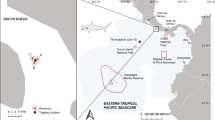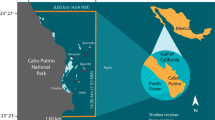Abstract
The nurse shark, Ginglymostoma cirratum, is an abundant coastal species widely distributed on both sides of the tropical and subtropical Atlantic Ocean. Despite being an endangered species in Brazil, information on bio-ecological aspects of this species is still very scarce. This study investigates seasonal fluctuations in abundance, sex ratio and residency of nurse sharks in coastal waters off Recife, northeastern Brazil. Total length of the specimens caught ranged from 107 to 300 cm. Sex ratio for nurse sharks was 1.31♀:1♂ but it showed a strong variation throughout the year. About 8% of tagged sharks were recaptured after an average of 248 days at liberty, at distances between 0.04 and 6.23 km from the tagging site. A growth rate of 15.77 ± 2.53 cm/yr was obtained from total length data collected from three recaptured specimens. Nurse sharks demonstrated some signs of affinity for temperatures between 25º and 30°C and salinities between 34 and 37. The combined analysis of longline and telemetry data indicated possible differences in habitat usage between sexes of nurse sharks off Recife.








Similar content being viewed by others
References
Afonso AS, Hazin FHV, Carvalho F, Pacheco JC, Hazin H, Kerstetter D, Murie D, Burgess GH (2011) Fishing gear modifications to reduce elasmobranch mortality in pelagic and bottom longline fisheries off Northeast Brazil. Fish Res 108:336–343
Agra G (2009) Organização social de elasmobrânquios na reserva biológica do Atol das Rocas, Brasil. Dissertation, Universidade Federal de Pernambuco
Bigelow HB, Schroeder WC (1948) Fishes of the western north Atlantic (Lancelets, cyclostomes and sharks). Mem Sears Found Mar Res, N. Haven
Carrier JC (1985) Nurse sharks of Big Pine Key: comparative success of three types of external tags. Florida Sci 48(3):146–154
Carrier JC, Luer CA (1990) Growth rates in the nurse shark, Ginglymostoma cirratum. Copeia 3:686–692
Carrier JC, Pratt HL (1998) Habitat management and closure of a nurse shark breeding and nursery ground. Fish Res 39:209–213
Carrier JC, Pratt HL, Martin LK (1994) Group reproductive behavior in free-living nurse shark, Ginglymostoma cirratum. Copeia 3:646–656
Castro JI (2000) The biology of the nurse shark, Ginglymostoma cirratum, off the Florida east coast and the Bahamas Islands. Environ Biol Fish 58:1–22
Castro ALF, Rosa RS (2005) Use of natural marks on population estimates of nurse shark, Ginglymostoma cirratum, at Atol das Rocas Biological Reserve, Brazil. Environ Biol Fish 72:213–221
Chapman DD, Pikitch EK, Babcock E, Shivji MS (2005) Marine reserve design and evaluation using automated acoustic telemetry: A case-study involving coral reef-associated sharks in the Mesoamerican Caribbean. Mar Tec Soc J 39(1):42–55
Compagno, LJV (2001) Sharks of the world. An annotated and illustrated catalogue of shark species know to date. N°1 Vol. 2. Bullhead, mackerel and carpet sharks (heterodontiformes, Lamniformes and Orectolobiformes). FAO Species Catalogue for Fishery Purposes, Rome
Garla RC, Chapman DD, Wetherbee BM, Shivji M (2006) Movement patterns of young Caribbean reef sharks, Carcharhinus perezi, at Fernando de Noronha Archipelago, Brazil: the potential of marine protected areas for conservation of nursery grounds. Mar Biol 149:189–199
Hazin FHV, Burgess G, Carvalho FC (2008) A shark attack outbreak off Recife, Pernambuco, Brazil: 1992–2006. Bull Mar Sci 82(2):199–212
Heupel MR, Simpfendorfer CA (2008) Movement and distribution of young bull sharks Carcharhinus leucas in a variable estuarine environment. Aquat Biol 1:277–289
Heupel MR, Simpfendorfer A, Heuter RE (2004) Estimation of shark home range using passive monitoring techniques. Environ Biol Fish 71:135–142
Heupel MR, Simpfendorfer CA, Collins AB, Tyminski JP (2006) Residency and movement patterns of bonnethead sharks, Sphyrna tiburo, in a large Florida estuary. Environ Biol Fish 76:47–67
Kohler NE, Turner PA (2001) Shark tagging: a review of conventional methods and studies. Environ Biol Fish 60:191–224
Klimley AP (1980) Observation of courtship and population in the nurse shark, Ginglymostoma cirratum. Copeia 4:878–882
Papastamatiou YP, Friedlander AL, Caselle JE, Lowe CG (2010) Long-term movement patterns and trophic ecology of blacktip reef sharks (Carcharhinus melanopterus) at Palmyra Atoll. J Exp Mar Biol Ecol 386:94–102
Pratt HL, Carrier JC (2001) A review of elasmobranch reproductive behavior with a case study on the burse shark, Ginglymostoma cirratum. Environ Biol Fish 60:157–188
Rosa RS, Castro ALF, Furtado M, Monzini J, Grubbs RD (2005) Ginglymostoma cirratum. in: 2007 IUCN Red List of Threatened Species, www.iucnredlist.org. Accessed 21 December 2010.
Santander-Neto J, Shinozaki-Mendes R, Silveira LM, Juca-Queiroz B, Furtunato-Neto MAA, Faria VV (2010) Population structure of nurse sharks, Ginglymostoma cirratum (Orectolobiformes), caught off Ceará State, Brazil, south-western Equatorial Atlantic. J Mar Biol Ass UK 91(6):1193–1196
Simpfendorfer CA, Heupel MR, Heuter RE (2002) Estimation of short-term centers of activity from an array of omnidirectional hydrophones and its use in studying animal movements. Can J Fish Aquat Sci 59:23–32
Sims DW (2003) Tractable models for testing theories about natural strategies: foraging behaviour and habitat selection of free-ranging sharks. J Fish Biol 63:53–73
Wetherbee BM, Gruber SH, Rosa RS (2007) Movement patterns of juvenile lemon sharks Negaprion brevirostris within Atol das Rocas, Brazil: a nursery characterized by tidal extremes. Mar Ecol Prog Ser 343:283–293
Wiley T, Simpfendorfer CA (2007) The ecology of elasmobranchs occurring in the Everglades National Park, Florida: implications for conservation and management. Bull Mar Sci 80(1):171–189
Acknowledgments
This work was funded by the State Government of Pernambuco. The authors would like to acknowledge the Conselho Nacional de Desenvolvimento Científico e Tecnológico (CNPq) for providing a scholarship to L. C. Ferreira and Instituto Chico Mendes de Conservação da Biodiversidade for providing the permits number 15083 and 21341 for scientific activities. The authors are also thankful to the crew of the R.V. Sinuelo and R.V. Pedrinho and to all interns from the Laboratório de Tecnologia Pesqueira (LATEP-UFRPE) for assisting with field work.
Author information
Authors and Affiliations
Corresponding author
Rights and permissions
About this article
Cite this article
Ferreira, L.C., Afonso, A.S., Castilho, P.C. et al. Habitat use of the nurse shark, Ginglymostoma cirratum, off Recife, Northeast Brazil: a combined survey with longline and acoustic telemetry. Environ Biol Fish 96, 735–745 (2013). https://doi.org/10.1007/s10641-012-0067-5
Received:
Accepted:
Published:
Issue Date:
DOI: https://doi.org/10.1007/s10641-012-0067-5




